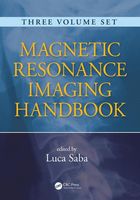LOW FIELD MRI / NMR
SELECTED PUBLICATIONS – PROJECTS
Published abstracts
- Concomitant B1 Field in Low-Field MRI: Potential Contributions to TRASE Image Artefacts, Tastevin G., Bidinosti C.P., Nacher P.-J., Proc. of the Intl. Soc. Mag. Reson. Med. 26 (2018) 2670 <Open archive HAL>
- Unconventional trajectories on the Bloch Sphere: A closer look at the effects and consequences of the breakdown of the rotating wave approximation, Bidinosti C.P., Nacher P.-J., Tastevin G., Proc. of the Intl. Soc. Mag. Reson. Med. 26 (2018) 2701 <Open archive HAL>
- A Fast MOSFET RF Switch for TRASE MRI at Low Magnetic Field, Nacher P.-J., S. Kumaragamage, Tastevin G., Bidinosti C.P., Proc. of the Intl. Soc. Mag. Reson. Med. 26 (2018) 1699 <Open archive HAL>
More Abstracts
- Exploration of gradient-free (TRASE) MRI at low field with hyperpolarized ³He Nacher P.-J., Tastevin G., Bidinosti C.P., Magn. Mater. Phys. 28 Suppl. 1 (2015) p. S64.
- An improved shielded RF coil for low-frequency NMR and MRI, Kuzmin V., Nacher P.-J. , Bidinosti C.P., and Hayden E., Magn. Reson. Mater. Phys. 26 Suppl. 1 (2013) 181-182.
- Signal feedback applications in MRI Kuzmin V., Safiullin K., and Nacher P.-J., Reson. Mater. Phys. 26 Suppl. 1 (2013) 33-34.
- Combining high resolution and high SNR in low-field MRI of hyperpolarised gases Safiullin K., Talbot C. and Nacher P.-J., Reson. Mater. Phy. 24 Suppl. 1 (2011) 366.
- ADC studies in phantoms and in preserved lungs using HP ³He MR at low-field Safiullin K., Talbot C. and Nacher P.-J., Reson. Mater. Phy.. 24 Suppl. 1 (2011) 368.
The MARGIN project
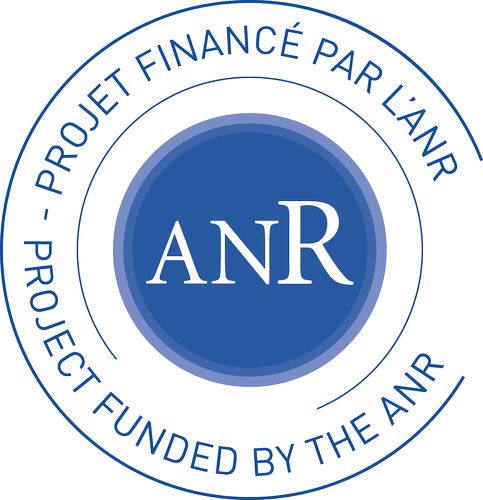 MARGIN (2020-2022) benefits from joint support from the French Agence Nationale de la Recherche and the Russian Science Foundation. It mainly deals with MAgnetic Resonance studies of Gas diffusion In Nanoporous materials. Investigations focus on of the influence of gas-wall interactions on NMR diffusion measurements.
MARGIN (2020-2022) benefits from joint support from the French Agence Nationale de la Recherche and the Russian Science Foundation. It mainly deals with MAgnetic Resonance studies of Gas diffusion In Nanoporous materials. Investigations focus on of the influence of gas-wall interactions on NMR diffusion measurements.
Regular article
- Signal feedback applications in low-field NMR and MRI. V. Kuzmin, P.-J. Nacher ⟨hal-02069159⟩
J. Magn. Reson. 310, 106622 (2020)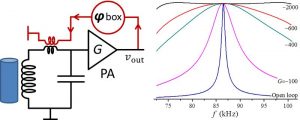
Abstract
Tuned pick-up coils with high quality factors Q are used in NMR and MRI for high-sensitivity and low-noise detection. However, large Q-factors introduce bandwidth issues at low frequency and the associated enhanced currents may cause significant radiation damping effects, especially with hyperpolarised samples. Signal feedback can be used to actively control these currents and adjust the detection bandwidth without resistive losses. Capacitive and inductive coupling methods are compared using detailed models and the operating conditions for efficient feedback with negligible noise penalty are discussed. Several high-impedance commercial preamplifiers have been found to affect the resonance characteristics of tuned coils in a gain-dependent way, or could not be used in low-frequency NMR because of oscillations at large positive gain. This is attributed to an undocumented internal feedback, and could be neutralised using external feedback. The implementation of an inductive coupling scheme to feed a suitably amplified phase-adjusted signal back into the PU coils of low-field NMR systems is described, and three experimental applications are reported. One system is used for NMR studies of distant dipolar field effects in highly polarized liquid 3He without or with radiation damping. The moderate intrinsic Q-factor (≈7) could be reduced (down to 1) or increased (up to 100) to control transient maser oscillations. Another system was used for MRI of water samples around 2~mT with Q≈190 Litz-wire detection coils. The detection bandwidth was increased by actively reducing the Q-factor to obtain uniform sensitivities in images and avoid artifacts introduced by intensity corrections. Finally, parallel acquisition in MRI was performed using two separately tuned detection coils placed above and below the sample. They were actively decoupled using two feedback systems. For an imaging field of view smaller than the sample, artifact-free unfolded images demonstrate the efficiency of this active coil decoupling scheme.
Regular article
Generating accurate tip angles for NMR outside the rotating-wave approximation, C.P. Bidinosti, G. Tastevin, P.-J. Nacher – J. Magn. reson. (2022) 345:1073062022 – hal-03765938 – Share link

Regular article
- A fast MOSFET rf switch for low-field NMR and MRI. 2019. P.-J. Nacher, S. Kumaragamage, G. Tastevin, C.P. Bidinosti ⟨hal-02266979⟩
J. Magn. Reson. 310, 106638 (2020)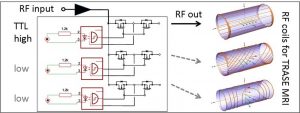
Abstract
TRansmit Array Spatial Encoding (TRASE) MRI uses trains of rf pulses alternatively produced by distinct transmit coils. Commonly used coil switching involving PIN diodes is too slow for low-field MRI and would introduce wait times between pulses typically as long as each individual pulse in a few mT. A MOSFET-based rf switch is described and characterised. Up to hundreds of kHz, it allows for sub-μs switching of rf currents from a single amplifier to several coils with sufficient isolation ratio and negligible delay between pulses. Additionally, current switching at null current and maximum voltage can be used to abruptly stop or start pulses in series-tuned rf coils, therefore avoiding the rise and fall times associated with the Q-factors. RF energy can be efficiently stored in tuning capacitors for times as long as several seconds. Besides TRASE MRI, this energy storage approach may find applications in fast repeated spin-echo experiments. Here, a three-fold acceleration of TRASE phase-encoding is demonstrated when MOSFET switches are used instead of fast reed relays.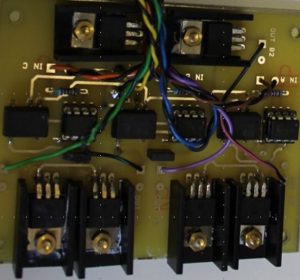
The prototype MOSFET-based switches have been made in-house by L. Pérennes and T. El Atmani (LKB electronic shop).
Book chapter
History and physical principles of MRI
by M. E. Hayden and P.-J. Nacher.
Magn. Reson. Imaging Handbook, vol. 1,
CRC press, 2016 (Ed. Luca SABA)
LOW FIELD NMR/MRI – PRECLINICAL LUNG MRI
Context
Magnetic resonance imaging (MRI) is a well-established and widely used diagnostic method relying on the detection of hydrogen nuclei (protons) in the (weakly) magnetised tissues of various body organs placed in a high magnetic field (routinely 1.5T or higher). Because of the low proton density in lung tissues and of the significant field inhomogeneity associated with their magnetic susceptibility and microscopic structure, MRI of lungs is normally very challenging. However, innovative MRI of the lung using hyperpolarised gases has been developed since 1996. It involves helium-3 or xenon-129 gas, first polarised by laser optical pumping, then inhaled and imaged by NMR techniques.
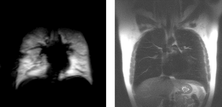 Chest images obtained using He3 MRI (left) or proton MRI (right).
Chest images obtained using He3 MRI (left) or proton MRI (right).
Courtesy of Jim Wild, Academic Radiology Dept., U. of Sheffield, UK.
An introduction to the history, principles, and operation of NMR and MRI, as well as more examples of lung images obtained using polarised gases, can be found in two book chapters:
“Magnetic Resonance Imaging: From Spin Physics to Medical Diagnosis“, by P.-J. Nacher (Poincaré Seminar, 2007).
“History and physical principles of MRI“, by M. E. Hayden and P.-J. Nacher (Magn. Reson. Imaging Handbook, vol. 1, CRC press, 2016 – Ed. Luca SABA)
Our group has been involved in hyperpolarised noble gas MRI since the beginning, in the mid nineties. We coordinated the European research project PHIL (2000-2004), then took part in the PHeLINet program (2007-2011) that carried on this collaborative work. We have also been involved in a broader network on the use of hyperpolarisation methods, Eurohyperpol (2011—2015).
The methodological investigations for pre-clinical in vivo work have been mostly carried out through collaborations in Orsay and Kremlin Bicêtre hospital (L. Darrasse, G. Guillot, et al) at U2R2M (now IR4M), at low (0.1 T) and high (1.5 T) field strengths. Research work performed at LKB focuses on developments at very low magnetic field NMR and MRI work (at a few milliteslas), with in-vitro and ex-vivo validation to lung MRI. [Refs]
MARGIN project
ANR-RSF support
International Collaborative Research Project
France (LKB, Paris) – Russian Federation (MRS lab., Kazan Fed. Univ.)
References
- [4] Concomitant B1 Field in Low-Field MRI: Potential Contributions to TRASE Image Artefacts, Tastevin G., Bidinosti C.P., Nacher P.-J., Proc. of the Intl. Soc. Mag. Reson. Med. 26 (2018) 2670 [ISSN 1545-4428 – Online]
- [3] Unconventional trajectories on the Bloch Sphere: A closer look at the effects and consequences of the breakdown of the rotating wave approximation, Bidinosti C.P., Nacher P.-J., Tastevin G., Proc. of the Intl. Soc. Mag. Reson. Med. 26 (2018) 2701 – [ISSN 1545-4428 – Online]
- [2] A Fast MOSFET RF Switch for TRASE MRI at Low Magnetic Field, Nacher P.-J., Kumaragamage S., Tastevin G., Bidinosti C.P.,Proc. of the Intl. Soc. Mag. Reson. Med. 26 (2018) 1699 [ISSN 1545-4428 – Online]
- [1] Exploration of gradient-free (TRASE) MRI at low field with hyperpolarized ³He, Nacher P.-J., Tastevin G., Bidinosti C.P., Magn. Mater. Phys. 28 Suppl. 1 (2015) p. S64.
References
- [1] Bidinosti, C.B. et al., J. Magn. Reson. 162 (2003) 122-132 : “In-vivo NMR of hyperpolarized ³He in the human lung at very low magnetic fields”.
- [2] Bidinosti, C.B. et al., Magn. Reson. Mat. Phy. 16, (2004) 255-258 : “MRI of the lung using hyperpolarized ³He at very low magnetic field (3 mT)”.
- [3] K. Safiullin, C. Talbot and P.J. Nacher, J. Magn. Reson., “Achieving high spatial resolution and high SNR in low—field MRI of hyperpolarised gases with Slow Low Angle SHot” , J. Magn. Res. 227 (2013) 72–86.
MAgnetic Resonance studies of Gas diffusion In Nanoporous materials
MARGIN at a glance Project homepage
MARGIN (2020 – 2022) – Project summary
In modern nanoporous materials, gas diffusivity correlates with their efficiency for gas separation and storage, or for catalysis. It also correlates with their relevance for investigations of helium superfluid phases and phase transitions with perturbing solid impurities, or confining boundaries since these systems essentially behave as low-density gases of quasi-particles at very low temperatures. More generally, gas and liquid diffusion measurement techniques are widely used for the characterization of porous media. Nuclear magnetic resonance (NMR) provides a wealth of non-invasive methods for measuring fluid transport in various kinds of porous systems. Gas diffusion NMR is a mandatory tool to address specific problems, such as finding mean free paths in aerogels and characterizing pore sizes and structure.
A precise understanding of all physical processes involved during diffusion measurements is essential to correctly interpret NMR diffusion results obtained in porous media. Gas diffusion in porous media near room temperature is frequently described by diffusion models which take into account the possible presence of adsorbed layers and the spatial structure of pores. However, usual phenomenological models of gas diffusion fail to account for observations made with strongly adsorbed gases or at low temperatures, because the influence of the attractive wall potential on molecular gas dynamics is overlooked in standard diffusion models. Preliminary results obtained for ³He gas diffusion in an ordered aerogel by the MRS Lab at 4.2 K revealed a significant deviation from the expected behavior, attributed to the increased effect of the aerogel adsorption potential on ³He gas diffusion at low temperatures. This effect of the adsorption potential is believed to manifest itself in an increase of the gas density and in changes of atomic trajectories near the walls in the gas phase.
Theoretical background and experimental data lack for gases in porous systems at low temperatures or low gas densities, and the MARGIN project is designed to address both issues. It aims at discriminating between confinement and wall adsorption effects through NMR investigations of gas diffusion in several well-characterized model porous media over a wide range of temperatures and gas densities for which different adsorption regimes are expected, from no adsorption to multilayer adsorption through Henry’s, Langmuir’s and BET’s regimes. Experimentally, ³He will be mainly used as a probe gas and apparent diffusion will be measured in porous systems such as ordered aerogels, nanopowders, etc., at low temperatures in MRS Lab (Kazan) and at high temperatures in LKB (Paris) using hyperpolarisation methods with laser optical pumping for high sensitivity. Complementary xenon gas diffusion experiments above 170 K are planned in the same porous media to probe diffusion of atoms with stronger adsorption potentials than for ³He. Numerical simulations of diffusion and nuclear spin dynamics will be also intensely used to reliably interpret experimental results and draw strong conclusions. MARGIN aims at demonstrating that NMR could become one of the accepted characterization tools for gas diffusion, instead of being limited to assessing diffusion and relaxation in liquids, inside porous media.
Besides the achievement of its main objectives, namely the detailed characterization of gas diffusion mechanisms in porous media, the MARGIN project is expected to yield data and results which might be relevant for different open questions in fundamental physics. One of them is related to recently revisited theories of motion-induced magnetic relaxation and frequency shifts in fluids, beyond the standard Redfield approach. On this topic, the planned NMR measurements in samples with near-planar confinement might provide a benchmark for these theories, which have been triggered by new generations of EDM search experiments.
Résumé en français
Une compréhension précise des processus en jeu lors de mesures de diffusion est essentielle pour interpréter les mesures de diffusion par RMN dans les poreux. Les modèles habituellement utilisés à température ambiante considèrent la présence de couche(s) adsorbées et la structure spatiale des pores, et échouent pourtant à expliquer les observations faites à basse température car ils négligent l’influence de l’attraction des parois sur les trajectoires atomiques dans le gaz. Des mesures préliminaires de diffusion à 4.2 K d’³He gazeux au laboratoire MRS dans un aérogel orienté ont montré une différence importante avec le comportement attendu, attribuée à une attraction accrue à basse température qui augmente la densité et affecte les trajectoires atomiques près des parois.
Les modèles théoriques et les données expérimentales manquent pour ces situations, et le projet MARGIN est destiné à élucider ces questions. Il vise à distinguer entre le confinement près des parois et l’adsorption par des mesures RMN de diffusion gazeuse dans une série de poreux bien caractérisés, dans une large gamme de températures et densités de gaz afin d’explorer différent régimes d’adsorption (Henry, Langmuir, BET). L’³He sera utilisé pour des mesures RMN de coefficient de diffusion apparent dans des systèmes poreux modèles (des aérogels anisotropes, des nanopoudres, etc.) à basse température (MRS Lab, Kazan) et 300 K (LKB, Paris) où le gaz sera hyperpolarisé par pompage optique laser afin d’atteindre la sensibilité nécessaire pour les mesures à basse densité. Des mesures complémentaires de diffusion de xénon au-dessus de 170 K seront faites dans les mêmes matériaux pour tester la diffusion d’atomes plus fortement attirés par les parois que ³He. Des simulations numériques de la diffusion gazeuse et de la dynamique RMN seront systématiquement menées pour valider l’interprétation des données et en tirer des conclusions fortes. MARGIN vise à démontrer que la RMN peut devenir une mesure de référence de la diffusion gazeuse dans les poreux, au lieu d’être limitée à la mesure de transport et de relaxation dans les liquides dans ces matériaux.
Au-delà de ses objectifs principaux, MARGIN fournira un ensemble de résultats qui pourraient être utiles à certaines études relevant de questions ouvertes en physique fondamentale. L’une d’elle concerne la théorie récemment reconsidérée de la relaxation magnétique et des déplacements de fréquences induits par le mouvement atomique dans les fluides, au-delà de l’approche standard de Redfield. Sur ce sujet, les mesures RMN prévues dans des échantillons avec confinement très anisotrope pourraient fournir un ensemble de données pour tester ces théories, qui ont été motivées par de nouvelles générations de mesures de moment dipolaire anormal (EDM).
Prior work:
Probing high-porosity silica aerogels with laser-polarised ³He gas
 References:
References:
“NMR measurements of hyperpolarized ³He gas diffusion in high porosity silica aerogels” (Full text, open access copy), TASTEVIN G. and NACHER P.-J., J. Chem. Phys. 123, 064506 [1−13] (2005). DOI : 10.1063/1.1997130
“NMR diffusion of hyperpolarised helium-3 in aerogel : a systematic pressure study“, GUILLOT G., NACHER P.-J., TASTEVIN G., Magn. Res. Im. 19, 391−394 (2001).
“Probing silica aerogel structure with spin-polarised helium-3“, TASTEVIN G., NACHER P.J., GUILLOT G., J. Low Temp. Phys. 121, 773−778 (2000).
Exploration of gradient-free (TRASE) MRI at very low field

The “Polarised Helium and Quantum Fluids” team, in collaboration with Prof. Chris. BIDINOSTI (U. Winnipeg, Canada), explores the feasibility of an innovative gradient-free magnetic resonance imaging (MRI) technique for low-field MRI of hyperpolarised ³He gas.
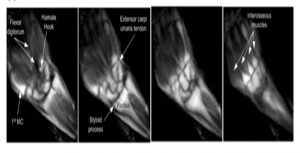
TRASE images of a human wrist, obtained at 0.2 T
[J.C. Sharp et al., NMR Biomed (2013) 26: 1602]
TRansmit Array Spatial Encoding (TRASE) MRI uses trains of radiofrequency 180°-tipping pulses produced by ”phase-gradient” coils which generate transverse B1 fields of uniform magnitude and spatially varying directions.1-3 If two such coils (A and B ), characterized by phase-gradients with different wave vectors (kA and kB), are used for tipping, the building block of a TRASE imaging sequence may be a pair of 180°-pulses successively applied with each coil: a pulse pair (180A, 180B) shifts the transverse magnetisation in k-space by an amount 2(kA – kB) as would do an applied gradient pulse of static field amplitude, B0, in standard NMR.
1 JC Sharp et al., Magn Reson Med 63:151 (2010); 2 JC Sharp et al., NMR Biomed, 26: 1602 (2013);
3 Q Deng et al., Magn Reson Imaging 31:891 (2013)
We are currently exploring the potential benefits and limitations of TRASE MRI at low magnetic fields.
In the millitesla field range, hyperpolarisation can be employed to obtain images with high signal-to-noise ration but the adverse effect of concomitant B0 gradients puts a limit to the resolution achievable in standard MRI: this issue is automatically solved in TRASE. However, to accommodate for changes in B1-field orientation, concomitant RF field components necessarily exist. Moreover, oscillating radiofrequency fields are used, consisting of equal rotating and counter-rotating components. In contrast with high-field NMR for which the concomitant and counter-rotative components simply contribute to radifrequency power deposition, time evolution in low field may be influenced by both since B1 magnitudes are not much smaller than B0.
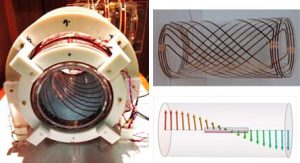
We perform experiments in a 15-cm bore resistive magnet (B0: 1‒5 mT), equipped with a usual radiofrequency coil (generating a field with uniform amplitude and phase), standard imaging gradient coils, and additional phase-gradient coils (generating a field with uniform amplitude and a phase that exhibits a linear variation along one direction) – see figure.
The efficiency of RF phase-encoding has been compared to that of encoding with B0-gradient pulses both in 1D and 2D imaging of water samples and sealed cells of ³He gas (hyperpolarized by optical pumping). Our initial results [Ref. 1] demonstrate the potential interest of the TRASE method. However, they display unexpected artefacts that are currently being investigated.
Systematic theoretical, numerical, and experimental investigations are underway to analyse the potentially adverse effects of the radiofrequency counter-rotating field [Re. 3] and concomitant field gradient [Ref. 4]. In particular, their joint effect leads to significant image artefacts when short 180°-pulses are used. We have designed and tested robust pulse sequences which are fairly immune to such effects. Generalisation of these studies to 2D and 3D gradient-free MRI is under way.
This page is under construction
Methodological developments at low magnetic field - Validation for lung MRI
Very low field MRI
Benefits for MR imaging of the lung
The major interest of operation at very low field is the drastic reduction the local field inhomogeneities due to the magnetic susceptibility of the lung tissues. This allows monitoring the evolution of the transverse magnetisation over very long time scales.
Pioneering work at LKB [1], [2], has established the increase of performances (in terms of signal-to-noise ratio and of probed length scales) and the potential interest of very low field MRI for:
– local measurement of gas diffusion inside the lungs, that characterises the size and the structure of the distal air spaces. The decrease of atomic mean free path measured in these air spaces is due to their highly divided topology, that can be significantly altered by lung pathologies such emphysema or some kinds of asthma.
– mapping of the transverse relaxation rates to image the variations of oxygen partial pressure in the air content, that provides information on the local or regional efficiency of functional gas exchanges.
– ventilation imaging, through optimal use of the available magnetisation for direct visualisation of the gas distribution inside the lungs.
Construction of a dedicated MRI system
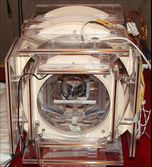 We have designed and built a compact system (15 cm i.d., 29 cm o.d.) for low field MRI (up to 5mT).
We have designed and built a compact system (15 cm i.d., 29 cm o.d.) for low field MRI (up to 5mT).
This is a 1:4 model of a whole-body imaging system developed for methodological investigations and demonstrations both in vitro and in small animals. It is equipped with a 3D gradient set and optimised radiofrequency coils. The system can be PC-controlled (using drivers developped at LKB) or run by a commercial NMR console.
We adjust the rf frequency or the magnetic field strength to achieve resonant excitation/detection of ³He nuclei and protons with the same hardware equipment.
Samples
³He samples are laser polarised on site, by metastability exchange optical pumping, which usually allows one-shot data acquisition. Optical pumping is performed either in situ (in a sealed gas cell that sits inside the MRI system, as shown in the above picture) or remotely (in a homebuilt gas polariser; in this case ³He is transferred into a valved measurement cell, together with a neutral buffer gas if needed). For proton NMR/MRI we use thermally polarised liquid samples (doped water enclosed in homebuilt sealed or valved containers). Signal averaging is thus mandatory to achieve reasonable signal-to-noise ratios.
Measurements of restricted diffusion
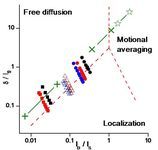
Innovative NMR sequences
Another study has been devoted to the development of an innovative MRI scheme for improved signal to noise ratio (SNR) and/or spatial resolution [3] (See below an in vitro demonstration — K. Safiullin, PhD work, 2011 — JMR article, 2013 [3]).
MRI and ADC studies have also been performed in commercial preserved cat lungs, demonstrating the potential of our set-up in spite of its current limitations. These studies, beyond their intrinsic interest, are expected to find applications in the preclinical MRI work that is pursued by various groups worldwide.

Centre: photographs of cells (5 cm long, 11 and 7 mm i.d.) filled with polarised ³He gas. Sides: k-space sampling schemes and resulting 2D MRI projection images obtained at 2.7 mT with our new Slow Low-Angle Shot (left) and the usual Fast Low-Angle Shot (right) sequences. A 1×1 mm² resolution (instead of 1.8×2.5 mm²) is obtained with the SLASH sequence for the same SNR.
LATEST COLLABORATORS
GRADUATE & UNDERGRADUATE STUDENTS
2019 - 2020
-
-
- Katia HO-SAKATA (Paris Diderot, M1) June – Aug. 2020, internship: Influence of concomitant RF fields on image quality in low field MRI.
-
2016 - 2017
-
-
-
- Jérôme Bouton (UPMC, M1) April-June 2017, internship: NMR dynamics in polarised ³He – Experimental versus numerical data.
-
-
2015 - 2016
-
-
-
- Modestin Sandjon (UPMC, M1) May-June 2016 internship: Implementation of Arduino microcontrollers in low-field NMR experiments.
- Ami Dramé and Janice Ronel (UPMC, L3) January 2016 internship: NMR and MRI at low magnetic field.
-
-
2013 - 2014
-
-
-
- Dan Moinard (Univ. College London) June-July 2014, MSci internship: NMR and MRI in hyperpolarised ³He gas.
-
-
PhD STUDENTS
- Kajum Safiullin
Magnetic resonance of hyperpolarised helium-3 at low magnetic fields
PhD thesis, Sept. 2011 — Work supported by PHeLINet (Marie Curie RTN)
SENIOR VISITORS
- Pr Christopher Bidinosti (University of Winnipeg, Canada)
Nov.2019, July 2019 – Work supported the CNRS
June – July 2018 – Work supported the CNRS
June – July 2017 – Work supported the CNRS.
Oct. – Nov. 2016 – Work supported the Univ. of Winnipeg.
August 2015 – Work supported by the CNRS.
Jan. – March, July, and Sept. – Oct. 2014
OTHER COLLABORATORS
- Sashika Kumaragamage (University of Winnipeg, Canada) August 2015

